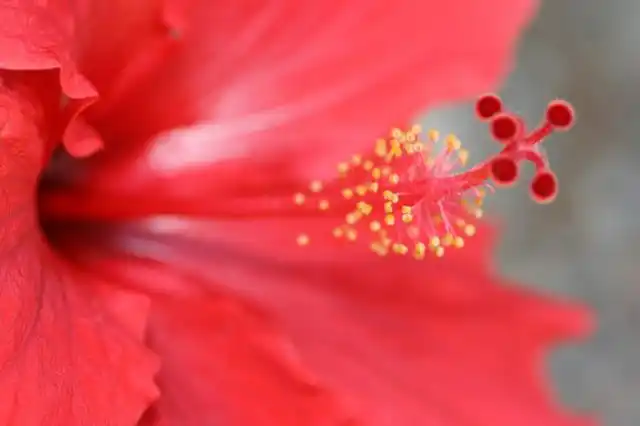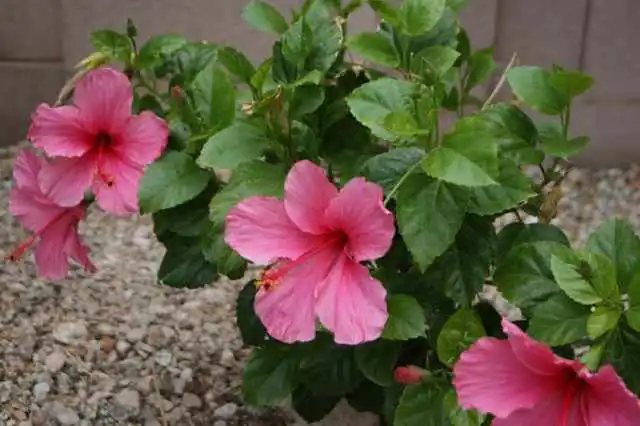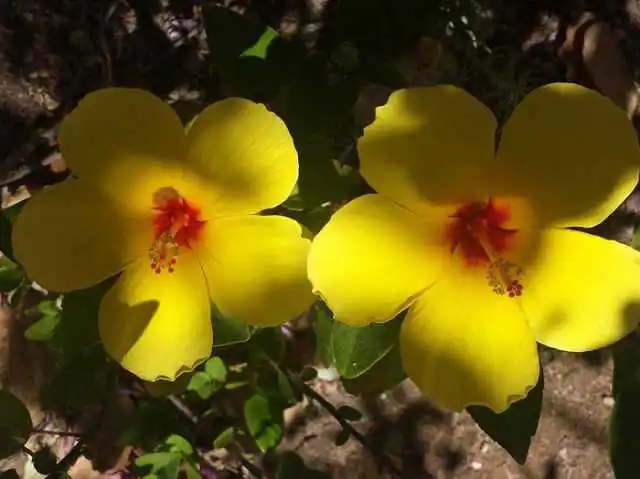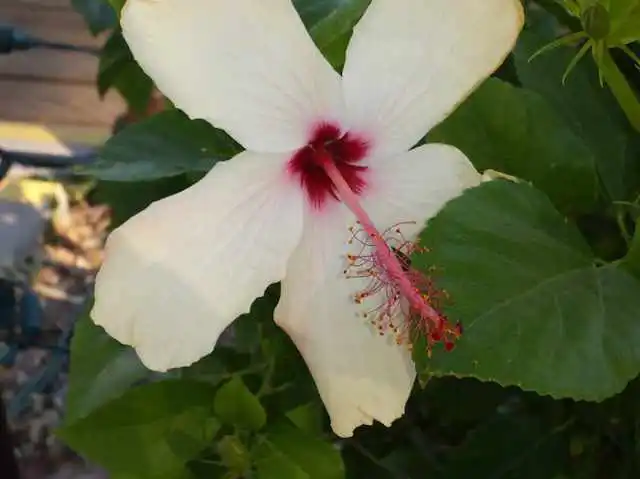Few plants scream tropical like the stunning hibiscus plant. This gorgeous tropical plant grows well in Arizona gardening zone 9b.
Hibiscus is a member of the mallow family. The plants have large, eye-catching flowers. These plants can be either annuals or perennials, depending on the variety and your climate. The plant is divided into one of two groups: tropical or hardy.
This post may contain affiliate links. Please see my disclosure policies. If you purchase after clicking an affiliate link we may receive small commission at no cost to you. As an Amazon Associate I earn from qualifying purchases.
Tropical or Hardy
In warmer climates like Arizona, the tropical variety of hibiscus are popular. This variety is perennial and stays green year-round. They cannot tolerate freezing temperatures and you will need to provide protection when the temps dip.
Why We Love Hibiscus
If your garden style is to create a tropical resort, this is the show stopping shrub to include in your garden. This beautiful plant looks great around a pool.
The bright, showy flowers attract bees, butterflies, and hummingbirds, helping to pollinate other plants in your garden.
Hibiscus flowers are edible. Use them to make teas, jams, and even salads. Hibiscus tea, known for its tart flavor and vibrant color, is a popular drink worldwide.
Where Can Hibiscus Grow?
Hibiscus thrives in warm climates and loves the sun. They are perfect for USDA hardiness zones 5 -11. Tropical varieties prefer the warmer gardening zones. If you live in a cooler climate, you can still enjoy this beautiful plant by growing them in containers that you can bring indoors during the winter.
Tropical hibiscus look great around a swimming pool or as a hedge. Anywhere you are looking for a tropical feel.
When to Plant Hibiscus
Spring is the ideal time to plant hibiscus, just after the last frost. Add hibiscus to your Phoenix garden in March. Your local nursery will have lots of colors to choose from at this time.
This timing gives the plants a whole growing season to establish themselves before the winter comes. If you’re planting a perennial variety, getting them in the ground early in the season ensures they’ll be strong and ready to survive the heat of summer and the cold winter.
How to Plant Hibiscus
Pick a location with full sun—hibiscus needs at least 6 hours of sunlight each day. In Arizona pick a location where the plant will receive morning sun and afternoon shade. We like to plant our hibiscus tucked under the shade of a palm tree.
The plant prefers well-drained, slightly acidic soil. If your soil is heavy clay, consider adding compost or peat moss to improve drainage.
Dig a hole that’s twice as wide and just as deep as the root ball of your hibiscus plant.
Place the plant in the hole, ensuring that the top of the root ball is level with the ground. Fill in with soil.
Water thoroughly after planting to help the plant settle in.
How to Care for Hibiscus
They are a relatively low-maintenance, but here are some tips to keep them thriving:
Water regularly, especially during dry spells, but make sure the soil drains well. In Arizona, your tropical hibiscus appreciates deep watering.
For beautiful showy flowers feed your hibiscus with a balanced fertilizer every couple of weeks during the growing season. A formula high in potassium will encourage more blooms.
Prune in early spring to shape the plant and encourage new growth. Remove any dead or weak branches to keep the plant healthy.
Keep an eye out for common pests like aphids and spider mites.
When Does Hibiscus Bloom?
The tropical variety in Phoenix blooms continuously from spring through winter.
The hibiscus flower is a large trumpet-shaped flower with five or more petals. They are native to tropical and sub tropical climates. The flower only blooms for one day, however the shrub is constantly flowering. The constant flowering ensures so you will almost always see a bloom on mature plants.
Most commonly seen in Phoenix are red, pink, yellow, salmon and orange in color. They are also available in purple, blue, white.
Varieties of Hibiscus
There are so many varieties of to choose from, each with its own unique charm. Here are a few popular ones:
Hibiscus rosa-sinensis
This is the variety you will find at all the local nurseries in Phoenix. Tropical Hibiscus known for their glossy leaves and vibrant flowers perform well in USDA gardening zone 9-11.
Grow as an annual in cooler climates. This variety is fast growing. It can grow up to 2 feet per year. At full maturity it can reach up to 15 feet.
Hibiscus moscheutos
If you live in a colder gardening zone, the Hardy Hibiscus variety is a good choice. These perennials can withstand colder temperatures and feature huge, dinner-plate-sized blooms. USDA Gardening zone 4-9, this variety blooms mid-summer to mid-fall. The average size is 4 feet high and 4 feet wide.
Hibiscus syriacus
This hardy variety is also known as Rose of Sharon. This shrub produces beautiful, smaller blooms and is great for hedges or borders. USDA gardening zone 5-9, this variety blooms early summer. It is deer-resistant.
Fun Fact
In Hawaii, the flower is traditionally worn behind a woman’s ear as a way to determine her availability (marital status.) If the flower is worn on the right side she’s taken, if worn on the left she’s looking.
Plants that Complement
- Lantana offers vibrant, multi-colored blooms and attracts pollinators.
- Bougainvillea adds a burst of color and can climb trellises for vertical interest. Just don’t plant this one near the pool.
- Daylilies provide continuous blooms and come in various colors.
- Ornamental Grasses for texture and contrast.
- Salvia‘s spiky flowers and drought tolerance complement
These plants will create a visually stunning, low-maintenance garden that thrives in zone 9.
Whether you’re planting them in the ground or in containers, hibiscus plants are sure to bring a touch of tropical paradise to your outdoor space. Happy gardening!




